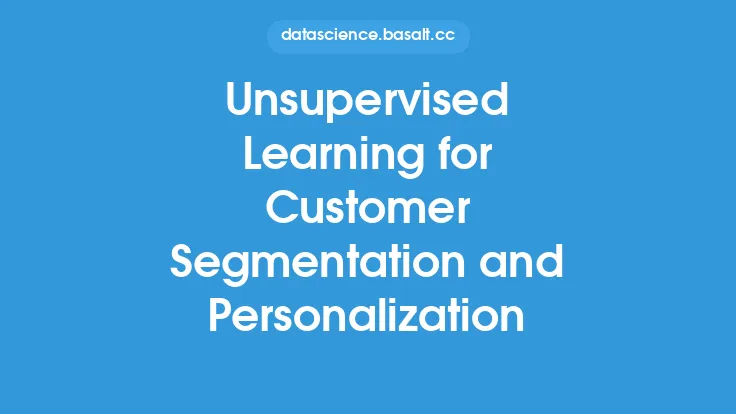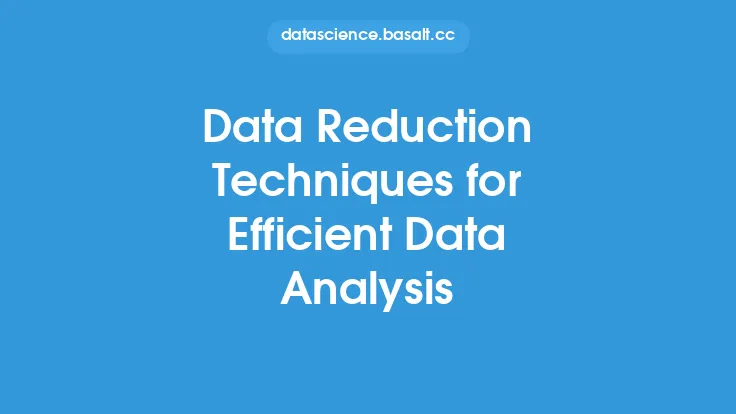Unsupervised learning is a crucial aspect of machine learning, where the goal is to identify patterns, relationships, and groupings within datasets without prior knowledge of the expected output. One of the significant challenges in unsupervised learning is dealing with high-dimensional data, which can lead to the curse of dimensionality, making it difficult to analyze and visualize the data. Dimensionality reduction techniques come to the rescue, providing a way to reduce the number of features or dimensions in a dataset while preserving the most important information. In this article, we will delve into the world of dimensionality reduction techniques for unsupervised learning, exploring the various methods, their strengths, and weaknesses.
Introduction to Dimensionality Reduction
Dimensionality reduction is a process of transforming high-dimensional data into a lower-dimensional representation, retaining the most critical features and discarding the less important ones. The primary goal of dimensionality reduction is to simplify the data, making it easier to analyze, visualize, and process. There are two main categories of dimensionality reduction techniques: feature selection and feature extraction. Feature selection involves selecting a subset of the most relevant features from the original dataset, while feature extraction involves transforming the original features into a new set of features that are more informative and compact.
Feature Selection Techniques
Feature selection is a widely used dimensionality reduction technique, which involves selecting a subset of the most relevant features from the original dataset. The key idea behind feature selection is to identify the features that are most correlated with the underlying patterns or relationships in the data. There are several feature selection techniques, including:
- Filter Methods: These methods evaluate each feature individually, using metrics such as correlation coefficient, mutual information, or recursive feature elimination. Filter methods are simple and efficient but can be prone to selecting redundant features.
- Wrapper Methods: These methods use a machine learning algorithm to evaluate the performance of different feature subsets. Wrapper methods are more accurate than filter methods but can be computationally expensive.
- Embedded Methods: These methods learn the feature selection and machine learning model simultaneously. Embedded methods are more efficient than wrapper methods and can provide better performance.
Feature Extraction Techniques
Feature extraction involves transforming the original features into a new set of features that are more informative and compact. There are several feature extraction techniques, including:
- Principal Component Analysis (PCA): PCA is a widely used feature extraction technique, which transforms the original features into a new set of orthogonal features called principal components. PCA is simple and efficient but can be sensitive to outliers and non-linear relationships.
- t-Distributed Stochastic Neighbor Embedding (t-SNE): t-SNE is a non-linear feature extraction technique, which maps the original features to a lower-dimensional space using a non-linear transformation. t-SNE is particularly useful for visualizing high-dimensional data but can be computationally expensive.
- Autoencoders: Autoencoders are a type of neural network that can be used for feature extraction. Autoencoders learn to compress the input data into a lower-dimensional representation and then reconstruct the original data from the compressed representation.
Linear Dimensionality Reduction Techniques
Linear dimensionality reduction techniques are a class of methods that use linear transformations to reduce the dimensionality of the data. These techniques are simple and efficient but can be limited in their ability to capture non-linear relationships. Some popular linear dimensionality reduction techniques include:
- Singular Value Decomposition (SVD): SVD is a factorization technique that decomposes a matrix into three matrices: U, Σ, and V. SVD can be used for dimensionality reduction by retaining the top-k singular values and the corresponding singular vectors.
- Independent Component Analysis (ICA): ICA is a technique that separates multivariate data into independent components. ICA can be used for dimensionality reduction by retaining the most informative independent components.
Non-Linear Dimensionality Reduction Techniques
Non-linear dimensionality reduction techniques are a class of methods that use non-linear transformations to reduce the dimensionality of the data. These techniques are more powerful than linear techniques but can be computationally expensive and prone to overfitting. Some popular non-linear dimensionality reduction techniques include:
- Isomap: Isomap is a non-linear dimensionality reduction technique that uses geodesic distances to preserve the global structure of the data.
- Locally Linear Embedding (LLE): LLE is a non-linear dimensionality reduction technique that uses local linear transformations to preserve the local structure of the data.
Evaluation Metrics for Dimensionality Reduction
Evaluating the performance of dimensionality reduction techniques is crucial to ensure that the reduced data retains the most important information. There are several evaluation metrics that can be used, including:
- Reconstruction Error: Reconstruction error measures the difference between the original data and the reconstructed data from the reduced representation.
- Preservation of Local Structure: Preservation of local structure measures the ability of the dimensionality reduction technique to preserve the local relationships and patterns in the data.
- Preservation of Global Structure: Preservation of global structure measures the ability of the dimensionality reduction technique to preserve the global relationships and patterns in the data.
Conclusion
Dimensionality reduction techniques are a crucial aspect of unsupervised learning, providing a way to simplify high-dimensional data and retain the most important information. There are various dimensionality reduction techniques, including feature selection, feature extraction, linear, and non-linear methods. Each technique has its strengths and weaknesses, and the choice of technique depends on the specific problem and dataset. By understanding the different dimensionality reduction techniques and their evaluation metrics, practitioners can make informed decisions and develop more effective unsupervised learning models.





